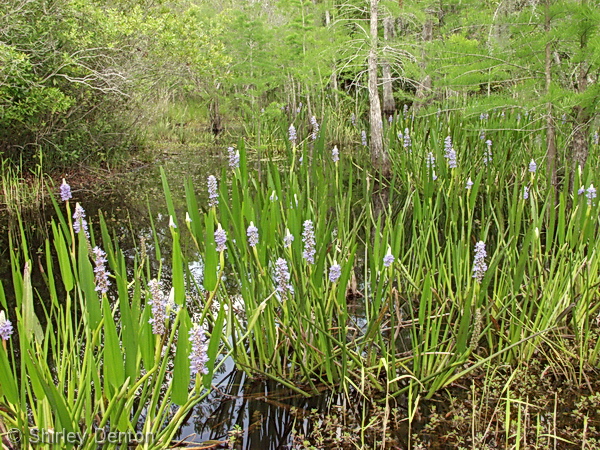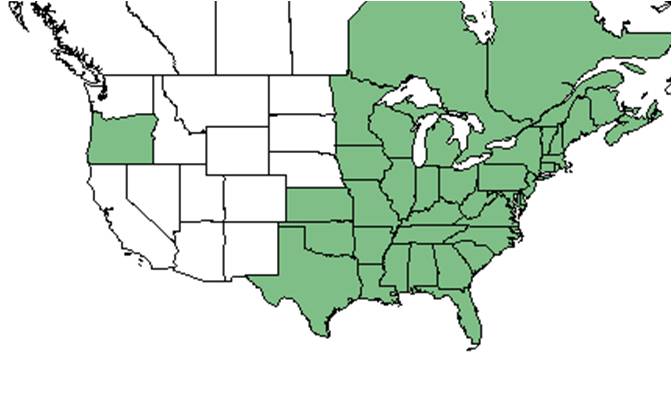Pontederia cordata
| Pontederia cordata | |
|---|---|

| |
| Photo by Shirley Denton (Copyrighted, use by photographer’s permission only), Nature Photography by Shirley Denton | |
| Scientific classification | |
| Kingdom: | Plantae |
| Division: | Magnoliophyta - Flowering plants |
| Class: | Magnoliopsida – Dicotyledons |
| Order: | Commelinales |
| Family: | Pontederiaceae |
| Genus: | Pontederia |
| Species: | P. cordata |
| Binomial name | |
| Pontederia cordata L. | |

| |
| Natural range of Pontederia cordata from USDA NRCS Plants Database. | |
Common name: pickerelweed
Contents
Taxonomic notes
Synonym: Pontederia cordata Linnaeus var. cordata
Cordata means heart shaped; Pontederia refers to the Italian physician Guilio Pontedera who kept the botanical gardens at Padua for 38 years.[1]
Description
A description of Pontederia cordata is provided in The Flora of North America.
Distribution
It is distributed Ontario to Nova Scotia and New England, south to northern Florida, west to Missouri and Oklahoma, north to Minnesota.[2]
Ecology
Habitat
Habitats of P. cordata include mucky soils of river floodplains, an outlet stream to a brackish marsh, shallow river water, cypress swamps, cypress-gum swamps, lake shores, open pools in gum swamps, and a river headwater marsh. It has also been found in disturbed areas such as open roadside ditches, along swamp logging roads, a weedy pond adjacent to a road, modified cypress-sawgrass exposed habitat, mowed roadside ditches, roadside cypress swamps, and the edge of a phosphate pool. Soil types include sandy peat and sandy-clay-alluvium. It has been observed to grow in shaded habitats. Associated species include Taxodium, Nyssa aquatica, Fraxinus tomentosa, Serenoa repens, Cyperus odoratus, Paspalum dissectum, and Echinochloa walteri.[3] It is used to stabilize pond banks.[4]
Phenology
It has been observed flowering March through November and fruiting April through October.[3] Flowers are hermaphroditic, and fruits contain one seed.[5]
Seed bank and germination
P. cordata seeds require a period of moist cold before germination and 8 weeks of stratification. Seedlings that germinate in the fall would unlikely survive the winter because of ice. Germination is primarily on stream bank sites where competition is low during seedling germination[6].
Pollination
This species is tristylous, with the typical populations having three morphs that differ in the positioning of the stigma and two anther levels. There is an over production of nectar, with a higher cost than is necessary to ensure pollen dispersal[7]. Pollen production is inversely proportional to stamen height[8].
The following Hymenoptera families and species were observed visiting flowers of Pontederia cordata at Archbold Biological Station: [9]
Megachilidae: Dianthidium floridiense
Use by animals
The leaves and stems provide good cover for birds, swimming mammals, fish, reptiles, amphibians and insects. Muskrats, white-tailed deer and geese eat the leaves, while the fruit is eaten by ducks and muskrats[10].
Conservation and management
Cultivation and restoration
The seeds can be boiled like greens[10].
Photo Gallery
Flowers of Pontederia cordata Photo by Shirley Denton (Copyrighted, use by photographer’s permission only), Nature Photography by Shirley Denton
References and notes
- ↑ [[1]] Eat the Weeds. Accessed: February 29, 2016
- ↑ [[2]]Lady Bird Johnson. Accessed: February 28, 2016
- ↑ 3.0 3.1 Florida State University Robert K. Godfrey Herbarium database. URL: http://herbarium.bio.fsu.edu. Last accessed: November 2015. Collectors: W.P. Adams, Loran C. Anderson, Sydney T. Bacchus, Tom Barnes, J. Beckner, Michael Cartrett, R.F. Christensen, A.F. Clewell, Kathy Craddock Burks, R.F. Christensen, G. Cruz, Delzie Demaree, R.F. Doren, Suellen Folensbee, J.P. Gillespie, Robert K. Godfrey, Bruce Hansen, JoAnn Hansen, N.C. Henderson, R.D. Houk, Meredith Jones, Edwin Keppner, R. Kerstetter, Robert Kral, Robert J. Lemaire, S.W. Leonard, William Lindsey, Sidney McDaniel, Richard S. Mitchell, B. Moore, Gwynn W. Ramsey, P.L. Redfearn Jr., Grady W. Reinert, Deborah R. Shelley, Cecil R. Slaughter, J.N. Triplett Jr., D.B. Ward, Jean W. Wooten, Brian Yahn. States and Counties: Florida: Bay, Brevard, Calhoun, Citrus, Collier, Columbia, DeSoto, Duval, Escambia, Flagler, Franklin, Gadsden, Glades, Gulf, Hamilton, Hillsborough, Holmes, Indian River, Jackson, Jefferson, Lafayette, Lake, Lee, Leon, Levy, Liberty, Madison, Nassau, Okaloosa, Orange, Pinellas, Polk, Putnam, Seminole, Sumter, St. Lucie, St. Johns, Taylor, Volusia, Wakulla, Washington. Countries: Honduras. Compiled by Tall Timbers Research Station and Land Conservancy
- ↑ [[3]]Accessed: January 29, 2016
- ↑ Ornduff, R. (1966). "The Breeding System of Pontederia cordata L." Bulletin of the Torrey Botanical Club 93(6): 407-416.
- ↑ Whigham, D. F. and R. L. Simpson (1982). "Germination and Dormancy Studies of Pontederia cordata L." Bulletin of the Torrey Botanical Club 109(4): 524-528.
- ↑ Harder, L. D. and S. C. H. Barrett (1992). "The Energy Cost of Bee Pollination for Pontederia cordata (Pontederiaceae)." Functional Ecology 6(2): 226-233
- ↑ Spencer, C. H. B., S. D. Price, et al. (1983). "Male Fertility and Anisoplethic Population Structure in Tristylous Pontederia cordata (Pontederiaceae)." Evolution 37(4): 745-759.
- ↑ Deyrup, M.A. and N.D. 2015. Database of observations of Hymenoptera visitations to flowers of plants on Archbold Biological Station, Florida, USA.
- ↑ 10.0 10.1 [[4]]Accessed: February 28, 2016
